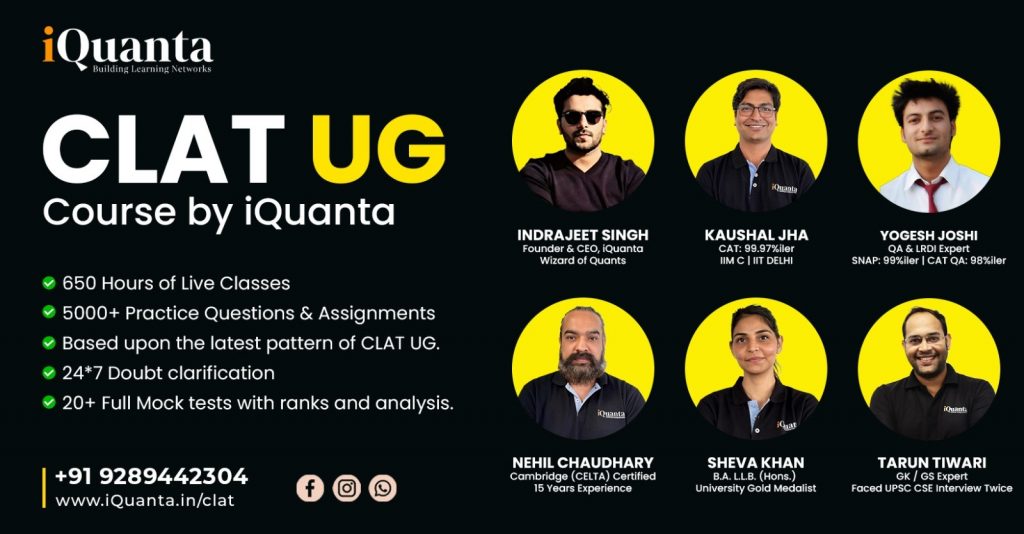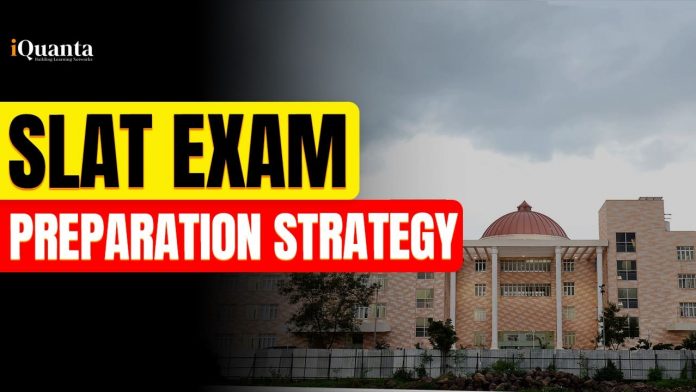Every year, Symbiosis International (Deemed University) conducts the Symbiosis Law Admission Test (SLAT), for admission into its 5-year integrated law courses which are B.A. LL.B (Hons.) and B.B.A LL.B (Hons.).

SLAT Preparation Strategy
If you want to ace the SLAT exam you need to focus equally on every section, as each section constitutes of 12 questions. In this article, we have provided a section-wise strategy for SLAT Preparation.
SLAT Preparation Strategy: Getting familiar with the Exam
Before diving straight into the Key Strategy, let us first explore the exam pattern, syllabus, and other basic details. Getting familiar with the exam is the best way to start your preparation.
SLAT Exam has a total of 60 questions. These questions are further divided into 5 sections,
- Logical Reasoning section tests your logical thinking ability and ability to identify patterns, correct/logical arguments, and identify logical links. The section includes topics like Assertion Reason, Logical consistency, Statement & Assumption, Statement & Arguments, Statement & Conclusion, Statement & Course of Action, Statement & Inference, Cause & Effect, Data arrangement, Directions, and Coding decoding.
- Legal Reasoning includes topics like the Indian Constitution, the Law of Torts, the Law of Contract, the Law of Crimes, Family Law, International Law, Important Judgement, Intellectual Property Rights, Legal Maxims, and Legal Terms.
- Analytical Reasoning includes Figure counting, Algebra, Percentage, Profit and Loss, Ratio and proportion, Number series, Decision Making, Time & Work, Analogy, Odd-one out, Arithmetic Reasoning, Blood Relations, Series – Number, Alphabet, Alphanumeric; Clock, Calendar, Distance & Directions.
- English is a section where you are tested on your vocabulary and reading skills. In the exam, you can get questions on Vocabulary, Grammar, Synonyms, Antonyms, Word Usage, Inference-based questions, Foreign Words/Phrases, and Para-Jumble.
- General Knowledge section contains both static and dynamic GK. The Dynamic section includes National Affairs International Affairs, State Affairs, Schemes & Plans launched by Govt. of India & States Awards & Honours, Books & Authors, Agreements & Deals, Sports, Science & Defence, Summits & Conferences, Current Economy, Appointments (National & International)
On the other hand, Static GK includes subjects like History – Ancient, Medieval, Modern, and World, Geography, National Park & Wildlife Sanctuary, Arts & Culture, General Science, Headquarters of National & International Organisations, Economy, Currency, and Capitals.
However, the number of questions will be the same for each of the sections in the SLAT Question Paper i.e. 12 questions per section.
SLAT Preparation Strategy: Logical Reasoning
Logical reasoning plays an important role in the Symbiosis Law Admission Test, i.e., SLAT. Since, the law is all about reading the legislation, rules, regulations, by-laws, etc., understanding the logical basis of the same, and giving them an apt interpretation, hence, a separate section is devoted to logical reasoning.
Logical reasoning is a branch that checks how well you can analyze the problem given and arrive at a logical conclusion. It aims at identifying whether as a straight-thinking person, you have the ability to understand the problem and reach the desired conclusion.
SLAT Preparation Strategy: Legal Reasoning
Legal Reasoning tests your ability to analyze and comprehend legal GK, principles, and facts. It evaluates your understanding of legal concepts, case laws, and their application.
Candidates must enhance their legal knowledge and practice solving legal reasoning questions to excel in this section. A strong foundation in legal reasoning is crucial to tackling this section and maximizing your overall score effectively.
In order to ace legal reasoning one should read and analyze case laws. Reading case laws improves your ability to interpret and apply legal principles.
SLAT Preparation Strategy: Analytical Reasoning
Analytical reasoning has around 12 questions from topics like Clocks, Calendars, Series, Coding-decoding, and blood relations only. In order to ace this section you need to revise all the basics of mathematics with a special focus on the mentioned areas. Do practice a sufficient number of questions from these areas, in order to become proficient in SLAT analytical reasoning section. Most of the questions require only a basic understanding of the concepts and hence can give you easy scoring options.
SLAT Preparation Strategy: Reading Comprehension
In order to ace the Reading comprehension section one should keep the following factors in mind:
- Develop a command over grammar. To do so one can revise all basic grammar rules.
- Develop a comprehensive vocabulary. To enrich your vocabulary, you can follow newspapers, news articles, good novels, and storybooks every day.
- Work on your comprehension skills. Reading from diverse sources and writing its summary is an exercise that can help you in developing your comprehension skills.
- Practice Reading comprehension. As the section presents 3 RCs (4 Questions each), practicing RCs regularly is very important for aspect for this section.
SLAT Preparation Strategy: General Knowledge
1) Static GK:
Although the syllabus is very vast, the questions from this section are relatively easy. You can easily attempt around 90% of Static General Knowledge questions if you intelligently plan your preparation. Topics of static GK should be covered from good and reliable sources.
2) Current Affairs:
SLAT paper consists of various questions from this section, which means that this section should not be ignored. The best way to prepare for Current Affairs is to read the newspapers daily. Newspapers like The Hindu, The Indian Express, etc. provide reliable information. Regional newspapers should be avoided. Apart from newspapers, magazines can also play a significant part in your preparation.
SLAT Preparation Strategy: Master Time Management
Time management is a vital component in an exam like SLAT, as here you don’t have any fixed sectional timings. One should allocate sufficient time to each section based on one’s proficiency in particular sections and the weightage of each section in the exam. Aspirants must develop effective time management strategies based on their strengths and weaknesses, to ensure that they can complete the exam within the stipulated time.
SLAT Preparation Strategy: Taking and Analyzing Mocks
By attempting the mock tests, aspirants can keep track of their performance, identify areas that need improvement, and develop effective test-taking strategies. Taking mocks boosts confidence, enhances time management skills, and builds familiarity with the exam pattern and difficulty level.
The Last step is Mock analysis, Analyzing mock is as important as taking mocks. Through mock-analysis one can explore their weak and strong areas and then work on them accordingly.
If you are looking for structured CLAT preparation along with a 24*7 doubt-solving facility, you can rely on iQuanta’s CLAT 2025 course.


